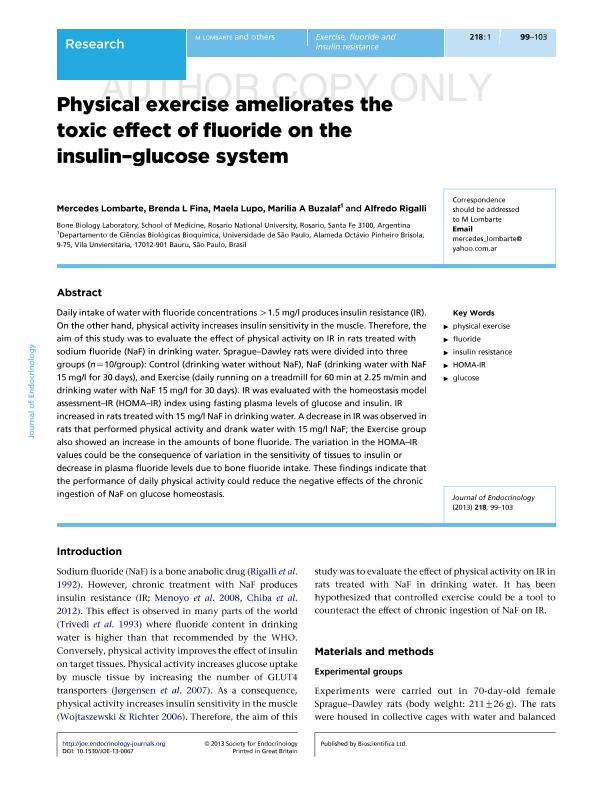Artículo
Physical exercise ameliorates the toxic effect of fluoride on the insulin–glucose system
Fecha de publicación:
05/2013
Editorial:
BioScientifica
Revista:
Journal of Endocrinology
ISSN:
0022-0795
e-ISSN:
1479-6805
Idioma:
Inglés
Tipo de recurso:
Artículo publicado
Clasificación temática:
Resumen
Daily intake of water with fluoride concentrations >1.5 mg/l produces insulin resistance (IR). On the other hand, physical activity increases insulin sensitivity in the muscle. Therefore, the aim of this study was to evaluate the effect of physical activity on IR in rats treated with sodium fluoride (NaF) in drinking water. Sprague–Dawley rats were divided into three groups (n=10/group): Control (drinking water without NaF), NaF (drinking water with NaF 15 mg/l for 30 days), and Exercise (daily running on a treadmill for 60 min at 2.25 m/min and drinking water with NaF 15 mg/l for 30 days). IR was evaluated with the homeostasis model assessment–IR (HOMA–IR) index using fasting plasma levels of glucose and insulin. IR increased in rats treated with 15 mg/l NaF in drinking water. A decrease in IR was observed in rats that performed physical activity and drank water with 15 mg/l NaF; the Exercise group also showed an increase in the amounts of bone fluoride. The variation in the HOMA–IR values could be the consequence of variation in the sensitivity of tissues to insulin or decrease in plasma fluoride levels due to bone fluoride intake. These findings indicate that the performance of daily physical activity could reduce the negative effects of the chronic ingestion of NaF on glucose homeostasis.
Palabras clave:
Physical Exercise
,
Fluoride
,
Insulin Resistance
,
Homa-Ir
,
Glucose
Archivos asociados
Licencia
Identificadores
Colecciones
Articulos(CCT - ROSARIO)
Articulos de CTRO.CIENTIFICO TECNOL.CONICET - ROSARIO
Articulos de CTRO.CIENTIFICO TECNOL.CONICET - ROSARIO
Citación
Lombarte, Mercedes; Fina, Brenda Lorena; Lupo, Maela; Buzalaf, Marilia A.; Rigalli, Alfredo; Physical exercise ameliorates the toxic effect of fluoride on the insulin–glucose system; BioScientifica; Journal of Endocrinology; 218; 1; 5-2013; 99-103
Compartir
Altmétricas




